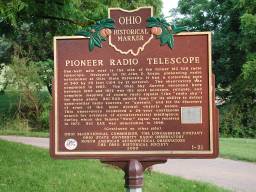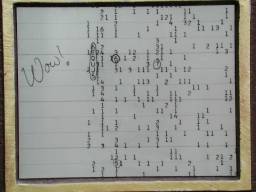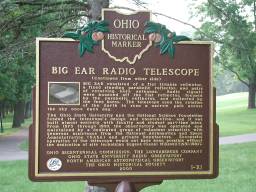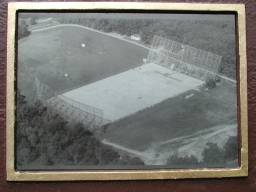| Front Side (Side 1) of Marker
 This photo shows Side 1 (the front side) of the Big Ear historical marker.
This photo shows Side 1 (the front side) of the Big Ear historical marker.
The text on this side is as follows:
PIONEER RADIO TELESCOPE
One half-mile east is the site of the former BIG EAR radio telescope.
Designed by Dr. John D. Kraus, pioneering radio astronomer at Ohio
State University, it had a collecting area of 340 by 70 feet
(104 by 21 meters). The observatory was completed in 1963. The Ohio
Sky Survey recorded here between 1965 and 1972 was the most accurate,
reliable and complete mapping of cosmic radio signals (the radio sky)
for many years. Big Ear gained fame for its ability to detect
quasi-stellar radio sources, or "quasars," and for its discovery of
some of the most distant objects known. This observatory conducted
a 24-year continuous search for evidence of extraterrestrial
intelligence, during which the famous "Wow!" signal was received in 1977.
BIG EAR was demolished in 1998.
|

On this front side is a photo of the famous "Wow!" signal received by the Big Ear telescope on August 15, 1977 and first noticed by Dr. Jerry Ehman. Since this signal was received only once, there is no definitive explanation for it. However, the signal does have the characteristics expected for a signal from an extraterrestial civilization.

At the bottom right of the marker (on each side) is a designation "1-21". It refers to the fact that this historical marker was the 1st marker in the 21st county in Ohio (there are 88 counties in Ohio and if their names are arranged in alphabetical order, Delaware County, where the marker is located, is the 21st county).
|
| Back Side (Side 2) of Marker
 This photo shows Side 2 (the back side) of the Big Ear historical marker.
This photo shows Side 2 (the back side) of the Big Ear historical marker.
The text on this side is as follows:
BIG EAR RADIO TELESCOPE
BIG EAR consisted of a flat tiltable reflector, a fixed standing
parabolic reflector, and pairs of receiving horn antennas. Radio
signals were bounced off the flat reflector, focused by the parabolic
reflector, and collected by the feed horns. The telescope used the
rotation of the Earth to scan a narrow path across the sky once each day.
The Ohio State University and the National Science Foundation funded the
telescope's design and construction, and it was built almost entirely
with faculty and student part-time labor. From 1973 through 1997, the
observatory was operated and maintained by a dedicated group of
volunteer scientists with generous assistance from the National
Aeronautics and Space Administration (NASA) and private benefactors.
Successful operation of the telescope would not have been possible
without the dedication of site technician Eugene (Gene) Mikesell
((1931 - 1987).
|

On this back side is an aerial photograph of the Big Ear radio telescope.
|
![[Aerial Photo of Big Ear]](../bigearhp.gif)
![[Aerial Photo of Big Ear]](../bigearhp.gif)
![[NAAPO Logo]](../NAAPOsm.jpg)